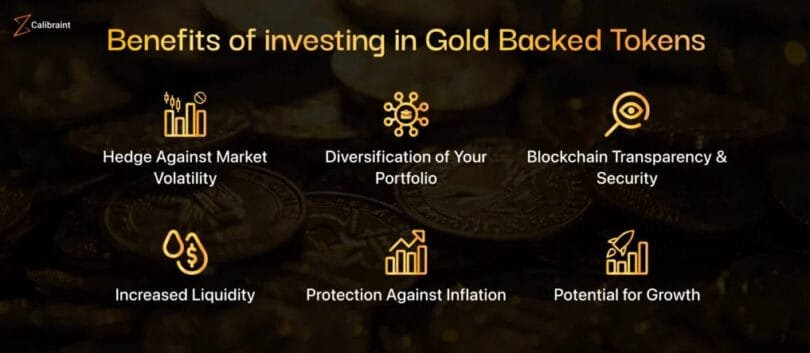Gold-backed cryptocurrencies bridge the gap between traditional precious metals and the digital world. These tokens, often called “digital gold,” are pegged to physical gold reserves stored in secure vaults. Each token represents a specific amount of gold, typically one troy ounce, making it easy to own a slice of the $12 trillion gold market without handling bars or coins.
Popular examples include Paxos Gold (PAXG) and Tether Gold (XAUT). PAXG, issued by regulated Paxos Trust Company, allows holders to redeem tokens for actual London Good Delivery gold bars. XAUT, from Tether, ties one token to one ounce of Swiss-vaulted gold meeting LBMA standards. Other players like Kinesis Gold (KAU) and Comtech Gold (CGO) offer similar setups, often with Shariah-compliant options.
This model infuses blockchain’s speed and transparency into gold’s stability. Audits ensure reserves match tokens, letting users verify holdings on-chain. As cryptocurrency backed by gold gains traction, it’s drawing in both crypto natives and gold bugs seeking digital convenience.
Explosive Growth and Market Momentum
The sector is booming amid economic jitters. By October 2025, gold-backed tokens surpassed $3 billion in market cap, up from $1.4 billion in Q1. PAXG alone hit $983 million, fueled by $141.5 million inflows since June. Tether minted 129,000 XAUT tokens in August, adding $437 million.
Minting volumes peaked at $439 million in August, a five-year high, driven by gold’s rally to $4,136 per ounce. Transfer volumes surged 53.7% month-over-month in February, outpacing broader crypto trends. Year-to-date, these tokens gained over 50%, holding firm during a $19 billion crypto rout.
Trade wars and inflation fears are accelerators. US-China tariffs and $37 trillion US debt push investors toward havens, with central banks allocating 24% of reserves to gold. This momentum signals a shift: Digital assets aren’t just speculative; they’re evolving into reliable stores of value.
Enhancing Stability in a Volatile Crypto Space
Crypto’s wild swings—Bitcoin’s 12% October drop—highlight the need for anchors. Gold-backed tokens deliver low volatility under 2%, tracking gold’s steady climb of 68% year-to-date. Unlike fiat stablecoins, they’re immune to depegging risks, backed by tangible assets.
They act as hedges during turmoil. In stress periods, PAXG and XAUT serve as safe havens for DeFi and NFT assets, reducing portfolio drawdowns. Studies show they decrease overall crypto volatility, fostering broader adoption by tempering the market’s “debasement trade.”
Fractional ownership lowers barriers—$50 buys gold exposure—while redeemability for physical bars adds trust. This stability attracts institutions, with Q1 ETF inflows mirroring $42.7 million in token issuance. As cryptocurrency backed by gold matures, it could redefine risk management in digital portfolios.
Revolutionizing DeFi and Real-World Applications
DeFi gets a stability boost from these tokens. Platforms like Aave and Uniswap integrate PAXG as collateral for loans, enabling yields up to 33% APY in liquidity pools. This brings gold’s reliability to yield farming, where volatile assets often falter.
Payments transform too. Instant, low-cost transfers via blockchain make cross-border remittances efficient—settling in minutes versus days for wires. Businesses in Asia use KAU for trade, bypassing intermediaries and inflation. In emerging markets, they preserve savings against currency erosion.
Tokenization solves gold’s old pains: Illiquidity and opacity. On-chain audits and 24/7 trading democratize access, with NFT integrations like GEM NFTs offering ownership proofs. This fusion is reshaping digital assets into practical tools, not just speculation vehicles.
Challenges and Regulatory Horizons
Growth isn’t without hurdles. Counterparty risks—if vaults fail, tokens lose backing—demand rigorous audits. Liquidity lags majors like BTC, with thinner volumes risking slippage. Fees, around 0.4% annually, and high redemption minimums (e.g., 430 ounces for XAUT) limit retail appeal.
Regulations are tightening. EU’s MiCA and US SEC view some as securities, requiring compliance that could slow innovation. Yet, this scrutiny builds legitimacy, potentially unlocking trillions in tokenized RWAs.
Environmental concerns from mining tie in, but recycling-focused tokens like those using 75% recycled gold counter this. Overcoming these will cement their role in global finance.
Future Prospects and Investor Strategies
By 2026, the market could double to $5-6 billion as gold eyes $4,200. AI audits and multichain support will enhance scalability, while CBDC pilots pegged to gold hint at mainstreaming.
For investors, allocate 5-10% for diversification. Buy dips tied to gold’s $4,070 support; stake in DeFi for yields. Pair with volatile crypto for balance—PAXG held steady in recent routs.
Gold-backed cryptos aren’t replacing Bitcoin; they’re elevating the ecosystem. As cryptocurrency backed by gold evolves, it promises a more resilient, inclusive digital economy.

